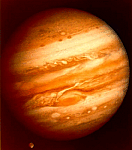|
Jupiter
 Jupiter is the largest planet in the Solar System. It weighs as
much as 318 whole Earths (twice the mass of all the other planets combined!).
Like most planets, Jupiter is a naked-eye object, known since antiquity.
Galileo used a telescope to discover moons of planets. It is
made of gasses and ices with a little rock and is believed to have
a solid core surrounded by liquid metallic hydrogen. This liquid metal
gives the planet its magnetic field. Despite its distance from the Sun,
Jupiter radiates more heat than it receives, a fact attributable to
the huge mass of the planet and the movements of its gasses.
Jupiter is the largest planet in the Solar System. It weighs as
much as 318 whole Earths (twice the mass of all the other planets combined!).
Like most planets, Jupiter is a naked-eye object, known since antiquity.
Galileo used a telescope to discover moons of planets. It is
made of gasses and ices with a little rock and is believed to have
a solid core surrounded by liquid metallic hydrogen. This liquid metal
gives the planet its magnetic field. Despite its distance from the Sun,
Jupiter radiates more heat than it receives, a fact attributable to
the huge mass of the planet and the movements of its gasses.
Jupiter’s most notable features are its giant red spot and its
overall colours. The Great Red Spot is a huge spinning mass of gas which
rotates slowly round the planet’s Southern Hemisphere. It is the
size of 2 Earths. The belts and bands of colour are caused by varying
winds pushing gasses containing different allotropes of sulfur across
the atmosphere.
Not long ago it was believed that Jupiter had no rings, but recently
a thin system of rings has been discovered around the planet. Jupiter’s
rings are believed to be made of small rocks and dust but, unlike other
ring systems, they contain no ice.
In 1994 Jupiter was hit by the fragments of the Shoemaker-Levy 9 comet
which exploded into its Southern Hemisphere. The blemishes from this
are still visible. It is events like this which replenish the dust and
matter in Jupiter’s ring.
|
Diameter
|
143, 000 km |
|
Mass
|
1.9 × 1027kg |
|
Mean Distance from sun
|
778,330,000 km |
|
Mean Density
|
1.33 g/cm3 |
|
Rotational Period
|
0.4 Earth days |
|
Orbital Period
|
4333 Earth days |
|
Mean Orbital Velocity
|
13 km/s |
|
Atmosphere
|
90% Hydrogen, 10% Helium |
|
Average Surface Temperature
|
-121°C |
|
Equatorial Surface Gravity
|
22.88 m/s2 |
|
 Jupiter is the largest planet in the Solar System. It weighs as
much as 318 whole Earths (twice the mass of all the other planets combined!).
Like most planets, Jupiter is a naked-eye object, known since antiquity.
Galileo used a telescope to discover moons of planets. It is
made of gasses and ices with a little rock and is believed to have
a solid core surrounded by liquid metallic hydrogen. This liquid metal
gives the planet its magnetic field. Despite its distance from the Sun,
Jupiter radiates more heat than it receives, a fact attributable to
the huge mass of the planet and the movements of its gasses.
Jupiter is the largest planet in the Solar System. It weighs as
much as 318 whole Earths (twice the mass of all the other planets combined!).
Like most planets, Jupiter is a naked-eye object, known since antiquity.
Galileo used a telescope to discover moons of planets. It is
made of gasses and ices with a little rock and is believed to have
a solid core surrounded by liquid metallic hydrogen. This liquid metal
gives the planet its magnetic field. Despite its distance from the Sun,
Jupiter radiates more heat than it receives, a fact attributable to
the huge mass of the planet and the movements of its gasses.